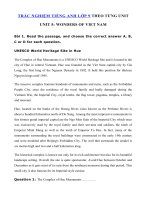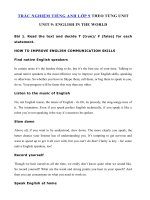Tải Trắc nghiệm Reading tiếng Anh lớp 11 Unit 5 Being Part Of ASEAN - Bài tập tiếng Anh 11 mới theo từng Unit có đáp án
Bạn đang xem bản rút gọn của tài liệu. Xem và tải ngay bản đầy đủ của tài liệu tại đây (92.44 KB, 7 trang )
<span class='text_page_counter'>(1)</span><div class='page_container' data-page=1>
<b>TRẮC NGHIỆM TIẾNG ANH LỚP 11 MỚI THEO UNIT</b>
<b>UNIT 4: BEING PART OF ASEAN</b>
<b>Bài 1. Read the following passage and mark the letter A, B, C, or D to indicate the</b>
<b>correct answer to each of the questions.</b>
When Malaysia takes the ASEAN chair next year, it will face a huge challenge. Too few
of us know enough about this grouping we call the Association of Southeast Asian
Nations. We do not know what it means to be a part of ASEAN and why it is important
to us. At the same time, pressure is mounting to reinvent ASEAN to make it more
people-centric and less government-centric. The Heat speaks to Global Movement of
Moderates CEO Saifuddin Abdullah on why ASEAN should mean more to us than just
<b>acronyms.</b>
ASEAN people do not feel like they are a part of the community of Southeast Asian
<b>nations. This statement, backed up by survey findings, is pretty bizarre, and extremely</b>
hurtful too, considering that ASEAN is 47 years old today. "Interview 10 persons on the
street and you would perhaps get only one of them who knows about ASEAN,” says
Datuk Saifuddin Abdullah. This CEO of Global Movement of Moderates (GMM) is not
running down ASEAN; he's confronting the truth as it impacts the project he has been
entrusted with. Here's more, in 2012, the ASEAN Secretariat conducted a survey that
showed only 34% of Malaysians had heard of the ASEAN community. This compares
with 96% of Laotians. Malaysia chairs ASEAN next year, and GMM is a member of the
national steering committee organising the ASEAN People's Forum (APF), a platform
designed to bridge the gap between governments and civil society. Never heard of it?
You're forgiven.
</div>
<span class='text_page_counter'>(2)</span><div class='page_container' data-page=2>
took the chairmanship of ASEAN again and founded the ASEAN People's Forum
(APF)," Saifuddin explains. In a perfect world, forums such as the APF or its
<b>predecessor APA would have worked perfectly to bridge the gap between government</b>
and civil society.
However, as Saifuddin points out, Civil Society Organisations (CSOs) often do not see
eye to eye with their governments. For instance this year, Myanmar is chair of ASEAN
and in the APF, three member nations - including Malaysia - decided not to recognise the
CSO leaders chosen as representatives so the APF did not take place. “This is where the
GMM wants to play a role in ensuring that this situation does not arise again," Saifuddin
says.
<b>Question 1: According to the passage, in 1990s, APF was called ____.</b>
A. ASEAN People's Assembly
B. ASEAN People's Forum
C. Civil Society Organisations
D. Global Movement of Moderates
<b>Question 2: The word “acronyms” in paragraph 1 probably means ____.</b>
A. abbreviations
B. antonyms
C. enlargements
D. synonyms
<b>Question 3: The phrase "backed up" in paragraph 2 has similar meaning to ____.</b>
</div>
<span class='text_page_counter'>(3)</span><div class='page_container' data-page=3>
C. proved
D. Supported
<b>Question 4: According to the passage, Datuk Saifuddin Abdullah was CEO of ____.</b>
A. APA
B. APF
C. CSOs
D. GMM
<b>Question 5: Which of the following statements is NOT true about the APF according to</b>
the passage?
A. APF consists of 20 leaders.
B. APF is held every two years.
C. APF is reorganised in 2005.
D. APF lasts for 30 minutes.
<b>Question 6: The phrase "bridge the gap" in paragraph 3 is closest in meaning to ____.</b>
A. avoid the conflict
B. break down the wall
C. build a strong relation
D. narrow the difference
<b>Question 7: Which of the following statements is TRUE according to the passage?</b>
</div>
<span class='text_page_counter'>(4)</span><div class='page_container' data-page=4>
B. Laotians show more interest in politics than Malaysians.
C. The APA was held twice a year until 2005.
D. CSOs do not always agree with their governments.
<b>Question 8: Which of the following would serve as the best title for the passage?</b>
A. How important was the ASEAN People's Forum?
B. Who is going to be the ASEAN chair next year?
C. What does it mean to be a part of ASEAN?
D. Why do GMM play an important role in ASEAN?
<i>Đáp án</i>
<i>1. A</i> <i>2. A</i> <i>3. D</i> <i>4. D</i> <i>5. B</i> <i>6. D</i> <i>7. D</i> <i>8. C</i>
<b>Bài 2. Read the following passage and mark the letter A, B, C, or D on your answer</b>
<b>sheet to indicate the correct answer to each of the questions.</b>
Cooperation is the common endeavor of two or more people to perform a task or reach a
<b>jointly cherished goal. Like competition and conflict, there are different forms of</b>
cooperation, based on group organization and attitudes.
In the first form, known as primary cooperation, group and individual fuse. The group
contains nearly all of each individual’s life. The rewards of the group’s work are shared
with each member. There is an interlocking identity of individual, group and task
performed. Means and goals become one, for cooperation itself is valued.
</div>
<span class='text_page_counter'>(5)</span><div class='page_container' data-page=5>
cooperation in the form of salary prestige, or power. Business offices and professional
athletic teams are examples of secondary cooperation.
In the third type called tertiary cooperation or accommodation, latent conflict underlies
the shared work. The attitudes of the cooperating parties are purely opportunistic: the
<b>organization is loose and fragile. Accommodation involves common means to achieve</b>
antagonistic goals: it breaks down when the common means cease to aid each party in
reaching its goals. This is not, strictly speaking cooperation at all, and hence the
somewhat contradictory term antagonistic cooperation is sometimes used for this
relationship.
<b>Question 1: What is the author’s main purpose in the first paragraph of to passage?</b>
A. To urge readers to cooperate more often
B. To offer a brief definition of cooperation
C. To explain how cooperation differs from competition and conflict
D. To show the importance of group organization and attitudes
<b>Question 2: The word “cherished” in paragraph 1 is closest in meaning to _______</b>
A. defined
B. agreed on
C. prized
D. set up
<b>Question 3: Which of the following statements about primary cooperation is supported</b>
by information in the passage?
</div>
<span class='text_page_counter'>(6)</span><div class='page_container' data-page=6>
B. It is most commonly seen among people who have not yet developed reading and
writing skills
C. It is an ideal that can never be achieved
D. It was confined to prehistoric times
<b>Question 4: According to the passage, why do people join groups that practice</b>
secondary cooperation?
A. To experience the satisfaction of cooperation
B. To associate with people who have similar backgrounds
C. To get rewards for themselves
D. To defeat a common enemy
<b>Question 5: Which of the following is an example of the third form of cooperation as it</b>
is defined in the fourth paragraph?
A. Students form a study group so that all of them can improve their grades
B. Members of a farming community share work and the food that they grow
C. Two rival political parties temporarily work together to defeat a third party
D. A new business attempts to take customers away from an established company
<b>Question 6: Which of the following is NOT given as a name for the third type of</b>
cooperation?
A. Tertiary cooperation
B. Antagonistic cooperation
C. Accommodation
</div>
<span class='text_page_counter'>(7)</span><div class='page_container' data-page=7>
<b>Question 7: The word “fragile” in paragraph 4 is closest in meaning to</b>
A. involuntary
B. poorly planned
C. inefficient
D. easily broken
<b>Đáp án:</b>
<i>1. B</i> <i>2. C</i> <i>3. B</i> <i>4. C</i> <i>5. C</i> <i>6. D</i> <i>7. D</i>
Mời bạn đọc tham khảo thêm tài liệu Tiếng Anh lớp 11 tại đây:
Bài tập Tiếng Anh lớp 11 theo từng Unit:
Bài tập Tiếng Anh lớp 11 nâng cao:
</div>
<!--links-->









